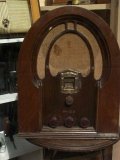Dangers of visually-based theoretical terms (as 'image') - warning by Alan Beck
| I have repeatedly warned about the intrusion of visually-based terms in core radio theory. |
| Visual - dominance of - Point-of-listening in radio plays - Beck, Alan, 1998, Sound Journal 4.2 |
| Of course, I am not the first to do so, and some such cross-over is unavoidable. But I object to the use of 'image' in core radio theory. |
| 'Image' has its place in reception theory for radio, especially if the internalist model (across all the sensory array) is followed. |

| Mostly do NOT use 'image' in core radio theory, and intead use 'representation' and 'simulacrum'. ('Simulacrum' in the sense of copy - but see Simulacrum - particular definition) |
| 'Image' can be used in radio reception theory. |
| This avoids the danger of 'equivocal use' of a key term. We have to use main terms to denote processes or suchlike which belong to the subject area - radio - and help us understand it. |
| We should keep to particular ways of thinking and knowing that are to do with radio and sound perception. |
| Linguistic philosophers have argued that images cannot be considered a language: images have no common elements similar to a written language's alphabet & images have no recognized syntax. (See Lester - below) |
IMAGE
| IMAGE AND THE VISUAL: 'Image' is connected with the 'visual' both in its root and its applications. |
| DEFINITION OF IMAGE CONNECTED TO THE VISUAL: "its visual quality comes closest to its character and, though far from given once the discussion turns to literary concerns, 'seeing' remains a constituent and source for almost all discourse on the nature of images. The affinity is suggested etymologically as well since 'image' means, among other things, 'idea' which stems from the Greek 'to see'" (The University of Chicago, Theories of Media, Keywords Glossary at http://csmt.uchicago.edu/glossary2004/image.htm) |

FILM THEORY AND IMAGE
| Film theory has based so much on the spatial relationship between the spectator and the screen, echoing Plato's cave and Lacan's mirror (Baudry 1970, p 294; Baudry 1975 pp. 302-306). |
| The narrative of consciousness in film becomes often 'the story of the eye', an organ which is not so much as part of the body, but 'a part of the mind' (Leo Steinberg). |
| References |
| Baudry, Jean-Louis, 1970, "Ideological Effects of the Basic Cinematographic Apparatus", Bill Nichols, ed. Movies and Methods Volume II. Berkeley: University of California Press, 1986 [essay written 1970]. |
| Lester, Paul, 'Syntactic Theory of Visual Communication' published in Visual Communication Images with Messages, (1995) Belmont, CA: Wadsworth Publishing Company, Chapter 17 also online at http://commfaculty.fullerton.edu/lester/writings/viscomtheory.html |




